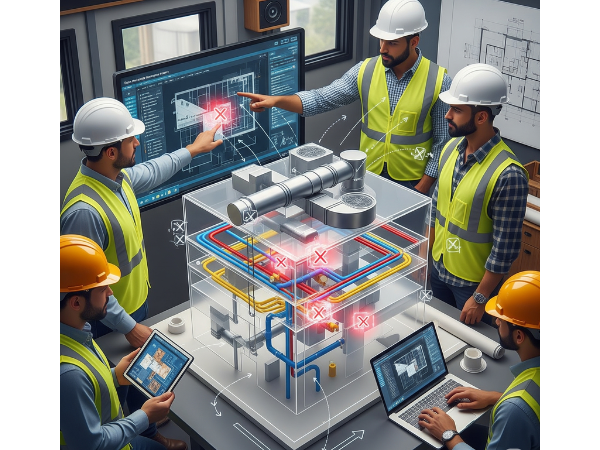In the dynamic world of Architecture, Engineering, and Construction (AEC), the skills required to succeed are constantly evolving. At the forefront of this evolution is Building Information Modeling (BIM), a process that is fundamentally changing how buildings and infrastructure are designed, constructed, and managed. For anyone aspiring to build a sustainable and successful career in the AEC industry, mastering BIM is no longer an advantage it’s a necessity. This blog post will explore why BIM is a crucial skill for a future-ready AEC career, and how acquiring it can be a smart gateway to long-term professional success.

The AEC Industry is Undergoing a Digital Transformation:-
The AEC sector has historically been slower to adopt new technologies compared to other industries. However, the push for greater efficiency, collaboration, and sustainability is driving a rapid digital transformation. BIM is the cornerstone of this change, replacing traditional 2D drafting with an intelligent, data-rich 3D modeling process. This shift is not just about using new software; it’s about a new way of working that demands a different skill set. Professionals who understand and can effectively utilize BIM are positioned to lead this transformation and are highly sought after in the job market.
1. Enhanced Collaboration and Communication:
One of the most significant benefits of BIM is its ability to foster seamless collaboration among project teams. By providing a single, centralized model, BIM ensures that all stakeholders from architects and engineers to contractors and owners—are working with the same, up-to-date information. This shared environment reduces the risk of errors and miscommunication, which are common pain points in traditional workflows. In an industry where successful projects hinge on effective teamwork, being proficient in BIM makes you an invaluable team member. The collaboration between contractors and structural engineers, for instance, is key to project success.
2. Improved Project Efficiency and Quality:
BIM streamlines the entire project lifecycle, leading to greater efficiency and higher quality outcomes. It allows for the early detection of clashes and conflicts between different building systems, such as structural, mechanical, and architectural elements, before construction even begins. This “clash detection” capability saves significant time and money by preventing costly rework on site. The detailed information within a BIM model also enables precise quantity takeoffs, accurate cost estimations, and optimized construction sequencing. This efficiency and attention to detail are what makes a BIM-skilled professional so valuable to any AEC firm.

3. Data-Driven Decision Making:
Beyond its use in design and construction, BIM generates a wealth of data that can be used for informed decision-making throughout a building’s entire lifecycle. The intelligent model can be used for advanced analyses, such as energy performance simulations, structural analysis, and lifecycle cost assessments. For example, in structural engineering, BIM allows for a deeper understanding of a building’s integrity. This capability extends to ongoing facility management, where the BIM model can be used to track assets, schedule maintenance, and plan for future renovations. Professionals who can leverage this data to provide insights and recommendations are not just designers or drafters; they are strategic problem-solvers.
BIM as a Smart Gateway to a Future-Ready Career:-
For those new to the field, investing in a career in BIM is a strategic move. BIM training serves as a smart gateway to a future-ready AEC career by providing the essential skills needed to thrive in this evolving industry.
Why BIM Training is Key:
- High Demand: The demand for BIM professionals continues to grow as more firms adopt the technology. Companies are actively seeking individuals who can navigate BIM software and processes.
- Career Advancement: Proficiency in BIM can open doors to a variety of roles, including BIM Coordinator, BIM Manager, and Digital Construction Manager. These positions often come with higher salaries and greater responsibilities.
- Versatility: BIM skills are transferable across various AEC disciplines. Whether you are interested in architecture, structural engineering, MEP design, or construction management, BIM provides a foundational skill set that is applicable everywhere. The principles can even be applied to specialized projects like bridge design.
- Relevance: The future of the AEC industry is digital. By acquiring BIM skills, you are positioning yourself at the cutting edge of this transformation, ensuring your expertise remains relevant and valuable for years to come.

In conclusion, Building Information Modeling is more than just a software tool; it is a transformative process that is reshaping the AEC industry. For aspiring and current professionals, embracing BIM training is a crucial step towards building a resilient, adaptable, and future-ready career. By mastering this skill, you are not just keeping pace with change you are becoming a driver of innovation and a key player in shaping the built environment of tomorrow.
FAQ’s:-
Q1: What is the main difference between BIM and traditional CAD?
A: Traditional CAD (Computer-Aided Design) uses digital tools to create 2D drawings. BIM is a process that creates an intelligent 3D model with rich data about every element, enabling better collaboration and analysis throughout a project’s lifecycle.
Q2: Do I need to be an engineer or architect to work with BIM?
A: No. While many BIM professionals have backgrounds in engineering or architecture, roles exist for people with diverse skill sets. BIM training can open doors to roles in coordination, management, and technical support.
Q3: How can I get started with BIM training?
A: There are many paths to getting started. You can take online courses, attend workshops, or enroll in a formal BIM training program offered by educational institutions or software providers. Gaining hands-on experience through personal projects is also highly recommended.
Q4: Is BIM only relevant for new construction projects?
A: No. BIM is also valuable for renovation and facility management projects. The data-rich model can be used to plan and execute renovations, and it provides a comprehensive record of a building’s systems for ongoing operations and maintenance.
Read More On:-
For more information about engineering, architecture, and the building & construction sector, go through the posts related to the same topic on the Specuwin Blog Page.
Find out more accurately what we are going to take off in the course of applying leading new technologies and urban design at Specuwin.
